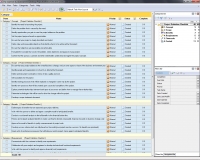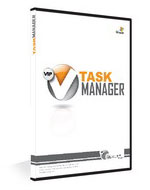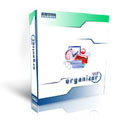|
Task Management Software |
 |
|
|
|
|
| |
|
 TESTIMONIALS TESTIMONIALS
|
|
"...This is an excellent program. I'm so glad that I stumbled on to this when researching for task management programs. Very low learning curv, quite flexible, and the price is right. Tried at least 20 other programs, either too complicated, too expensive, or poor documentation..."
Chad Lindsey -
Honolulu, HI
|
|
|
|
|
|
|
|
Project Definition Checklist |
|
|
|
|
|
|

 |
This Project Definition Checklist is designed to help you explore key questions about what defines the concept and mission of your project. The checklist covers such aspects as scope, requirements, constraints, benefits, measurement criteria, success metrics, and others.
|
| Order 750 checklists in MS Word and PDF printable format at $49.99 USD only. |
BUY NOW!  |
- Concept.
- Identify the need for launching the project.
- Define the problem that is caused by the need.
- Identify opportunities you gain in case the project addresses the problem.
- Set the project purpose based on opportunities.
- Be sure that your project is clearly described and stated.
- Define clear and measurable objectives that identify what is to be achieved by the project.
- Be sure that objectives are reasonable and achievable.
- Formulate the concept that covers the problem, need, objectives and purpose of your project.
- Confirm that the sponsor, customer and other stakeholders understand and agree the project concept.
- Scope.
- Be sure that your project addresses the overall business change, not just some aspect or facet of the business environment your company operates in.
- Identify people and organizations involved in or affected by the project.
- Define and document constraints in terms of time, quality and cost.
- Set boundaries for the project.
- Identify existing processes that will be replaced or changed in some way by the project.
- Identify new processes that will be created upon successful completion of the project.
- Explore potential relationships between both types of processes and define how to manage these relationships.
- Determine technologies that will be used to drive the change within the project.
- Develop a scope statement document.
- Benefits.
- Outline types of benefits that are expected upon project delivery.
- Work with the sponsor to define and agree a complete model of anticipated benefits.
- Conduct a cost-benefit analysis to limit all benefits to the financial bottom line.
- Review and evaluate analyzed benefits to make sure they’re desired, measurable, financial, focused on business change, and achievable.
- Approve the model of benefits to justify commencement of project work.
- Develop success criteria which are fully based on the model (your project reaches success if its benefits are produced).
- Create a list of performance measures that will help you monitor project status against anticipated benefits.
- Requirements.
- Communicate with the customer to identify user requirements.
- Collaborate with your analysts and engineers to develop technical and functional requirements.
- Work with the sponsor to identify and approve financial (cost) requirements.
- Request the project manager for review and approval of all kinds of project requirements.
- Develop a requirements statement document that explores and describes all approved requirements.
- Timescale.
- Make a timeline that defines the total amount of time required to deliver the project and produce its benefits, under the stated scope and requirements.
- Set commencement date and finish date for your project.
- Check if there are specific external requirements for project timing (e.g. legislation changes, contracts with third parties, etc.).
- Divide the timeline into smaller spans that determine durations for intermediate stages and phases of the project.
- Estimate activity durations to define timing for activities and tasks of every phase and stage.
- Define milestones (points on the timeline to define when to check project status against anticipated benefits).
- Develop a schedule that is based on your timeline and includes all the components that define overall timing of your project.
- Control.
- Be sure that all the components of your project are well defined and shared among authorized personnel.
- Confirm that the project is provided with all necessary people, resources, funding, and technology.
- Understand risks surrounding the project and share your understanding among others.
- Develop a risk management plan to underpin your considerations regarding threats, uncertainties and identified risks.
- Control consumption of limited resources throughout the course of work.
- Confirm that there is absolute commitment from your personnel.
- Be sure that your employees understand the project idea and are read...
| Order 750 checklists in MS Word and PDF printable format at $49.99 USD only. |
BUY NOW!  |
|





 |
CentriQS Tasks Management Solution 
Looking for multi-user task management software? Try CentriQS complete task management solution for planning, tracking and reporting tasks, projects, and schedules. Increase productivity of your small business or office by better organizing your employees' tasks and time.
 FREE Download CentriQS FREE Download CentriQS
|
|
|
|
|
|
|
|
|
|
CentriQS  -15% OFF -15% OFF |
All-in-one business management software
for small and midsize enterprises |
 |
|
|
| VIP Task Manager |
Multi-user project management software
to plan, schedule and track project tasks. |
 |
|
|
| VIP Checklists
|
More than 750 ready-to-use to-do lists
to plan your personal and business life |
 |
|
|
| VIP Team To Do List |
Professional task management software
to make and send team todo lists by email |
 |
|
|
| VIP Organizer |
Personal time management software
to organize time at home and at work |
 |
|
|
| VIP Simple To Do List
|
Simple and effective to-do list software
to plan daily chores, trips, wedding, etc. |
 |
|
|
|
|
|
|
|